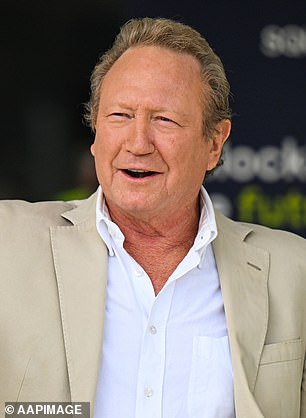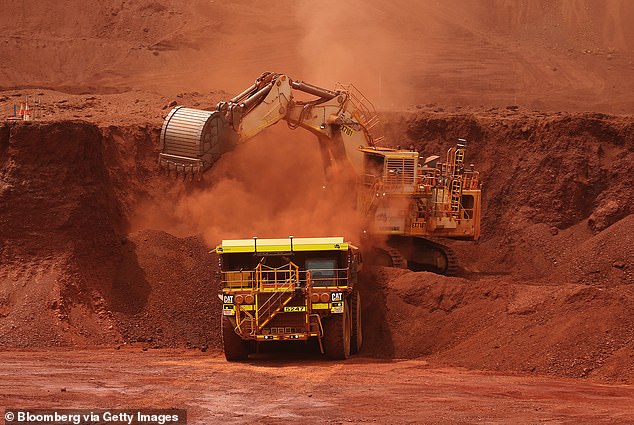The ‘Golden Mile’ in Western Australia was once considered the richest square mile in the world after prospectors flocked here during the gold rush of the late 19th century.
It is now at the epicenter of a global battery metals price crash, as a slowdown in electric vehicle sales has coincided with a surge in supply.
The Goldfields region has become a magnet for a new wave of prospectors, from local billionaires to global mining giants and small-time speculators, all vying for the abundance of lithium that also lies beneath the red earth.
So much so that a vast expanse of desert situated near the historic gold mining town of Kalgoorlie has been dubbed the “lithium power corridor”.
Lithium is a key component of lithium-ion batteries that have driven the global transition from internal combustion to electric vehicles.
Oversupply: The ‘Golden Mile’ in Western Australia, once considered the richest square mile in the world, is at the epicenter of a global slump in the price of battery metals.
Coveted and expensive, it has been called “white gold.” Western Australia is the world’s largest source of hard rock lithium, providing around half of the world’s supply.
It is a major supplier of nickel (with 23 percent of the planet’s known reserves of this substance), another key component of electric batteries.
And, although the vast majority of cobalt is found in the Democratic Republic of the Congo, Western Australia has a lot of it too. But the boom times for battery metals quickly turned into a boom.
After soaring since 2017, lithium prices have fallen more than 80 percent since the end of 2022, while nickel and cobalt have also fallen by around 40 percent.
Nickel and lithium prices have fallen so low that some mines have reduced production or been suspended until they recover, while hundreds of employees have been laid off.
Late last month, the world’s largest hard rock lithium mine, Greenbushes, located south of Perth (well outside the “power corridor”), announced it would cut production in the coming months to cope with the Lower demand for battery grade Lithium.
It is jointly owned by a partnership between Australian company IGO and Chinese miner Tianqi Lithium, and US giant Albemarle.
IGO announced last week that it would close its troubled Cosmos nickel mine, while iron ore billionaire Dr Andrew Forrest is mothballing the nickel mines just months after purchasing them.
Rio Tinto, the FTSE 100-listed Anglo-Australian miner, is not immune. It has applied for licenses to explore more than 500 square miles in the lithium corridor.
But it has also refused to pay inflated prices during a series of mergers and acquisitions, in case lithium prices plummet.
This strategy has protected Rio and put it in a prime position to snap up troubled mining assets at a low price.

Suspension operations: iron ore billionaire Andrew Forrest
The sharp drop in nickel prices has been driven by a China-driven supply surge from Indonesia, the world’s largest miner of the metal.
The Indonesian government bans the export of nickel and wants the country to become a nickel processing center, attracting foreign investment.
China has been happy to oblige, pouring money into Indonesia to develop new nickel mines, expand existing ones and build nickel smelters.
This has boosted nickel production in Indonesia, which has increased its market share from just 2 percent in 2015 to 49 percent of global supply last year.
China’s investment in Indonesia is part of its master plan to maintain its dominance over the battery metals supply chain.
Australia exports 97 percent of its lithium to China (the world’s largest manufacturer of electric cars and the batteries that contain them) for refining.
But the main reason for the drop in prices of various battery metals is the drop in demand for electric vehicles.
Countries around the world have struggled with high inflation and slowing economies, leaving expensive electric cars out of reach of households.
An energy crisis sparked by Russia’s invasion of Ukraine has also encouraged many governments to water down their commitments to going green, cutting tax incentives for both consumers and miners.
In a recent note to investors, senior lithium analyst Allan Pedersen at business management consultancy Wood Mackenzie said: “Reduced government incentives and inadequate charging infrastructure are expected to reduce (electric vehicle) sales in 2024.” .
He has predicted that lithium and other battery metals will remain oversupplied for several years, but highlighted that “industry fundamentals remain excellent, driven by the global push to decarbonize.”
Long-term investors sniffing out a bargain would do well not to jump the gun, as lithium and nickel prices are widely expected to fall further before recovering.
Meanwhile, there may be better news for drivers, as Tesla boss Elon Musk is among those insisting that lower prices for battery metals will eventually make electric cars more affordable.
Some links in this article may be affiliate links. If you click on them, we may earn a small commission. That helps us fund This Is Money and keep it free to use. We do not write articles to promote products. We do not allow any commercial relationship to affect our editorial independence.


